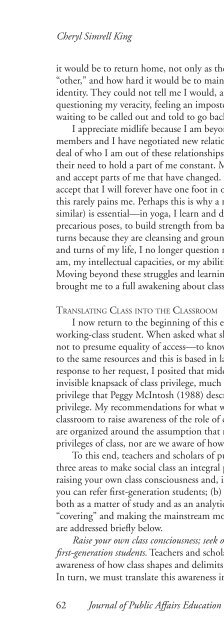WINTER 2012 - National Association of Schools of Public Affairs and ...
WINTER 2012 - National Association of Schools of Public Affairs and ...
WINTER 2012 - National Association of Schools of Public Affairs and ...
Create successful ePaper yourself
Turn your PDF publications into a flip-book with our unique Google optimized e-Paper software.
Amy E. Smith <strong>and</strong> Ignacio J. Martinez-Moyano<br />
student motivation, participation, <strong>and</strong> engagement; increases students’ desire<br />
to memorize, not underst<strong>and</strong>; <strong>and</strong> helps decrease practitioner quantitative skills<br />
to underst<strong>and</strong> <strong>and</strong> use research findings. As anxiety about statistics increases,<br />
student motivation, participation, <strong>and</strong> engagement decreases. Furthermore, as<br />
student motivation, participation, <strong>and</strong> engagement decreases, anxiety about<br />
statistics increases even further.<br />
Among the important hypothesized relationships in this model are several<br />
feedback mechanisms, indicated by R1, R2, R3, <strong>and</strong> R4 <strong>and</strong> identified with<br />
bold arrows in Figure 3. As discussed in the introductory section <strong>of</strong> this paper,<br />
the first feedback mechanism, the production-consumption loop (R1), shows<br />
the positive feedback relationship between the production <strong>of</strong> research <strong>and</strong> the<br />
consumption <strong>of</strong> research. As the quantity, quality, <strong>and</strong> relevance <strong>of</strong> research<br />
production increases, ceteris paribus, the extent <strong>and</strong> adequacy <strong>of</strong> research use will<br />
also increase. In addition, as research is used more by practitioners, the quantity<br />
<strong>and</strong> quality <strong>of</strong> research that is relevant to practitioners being produced will also<br />
increase. Thus a positive reinforcing feedback mechanism, which exists between<br />
the production <strong>and</strong> consumption <strong>of</strong> research, is created.<br />
Building on the positive reinforcing relationship between the production<br />
<strong>of</strong> research <strong>and</strong> the consumption <strong>of</strong> research, the improvement-by-success loop<br />
(R2) hypothesizes that as practitioner quantitative skills to underst<strong>and</strong> <strong>and</strong><br />
use research findings increase, so will the extent <strong>and</strong> adequacy <strong>of</strong> research use.<br />
As the extent <strong>and</strong> adequacy <strong>of</strong> research use increases, the success <strong>of</strong> policy<br />
implementation increases; <strong>and</strong> the perceived value <strong>and</strong> worth <strong>of</strong> statistics will<br />
also increase. When the success <strong>of</strong> policy implementation <strong>and</strong> perceived value<br />
<strong>and</strong> worth <strong>of</strong> statistics use increases, this will only further increase practitioner<br />
quantitative skills, thus creating a positive reinforcing mechanism between<br />
practitioner quantitative skills, use <strong>of</strong> research, <strong>and</strong> success <strong>of</strong> research-based<br />
policy implementation.<br />
In the tools-influence-attitude loop (R3), two <strong>of</strong> the challenges inherent<br />
in teaching statistics, designing tools effective for learning <strong>and</strong> student desire to<br />
memorize, not underst<strong>and</strong>, are salient. In this feedback mechanism we capture the<br />
idea that with increased availability <strong>and</strong> use <strong>of</strong> tools effective for learning, the<br />
students’ desire to memorize, not underst<strong>and</strong> decreases, leading to higher levels<br />
<strong>of</strong> quantitative skills. With increased quantitative skills, higher levels <strong>of</strong> use <strong>of</strong><br />
research will be achieved, leading to additional success <strong>of</strong> policy implementation<br />
that, in turn, will increase the availability <strong>and</strong> use <strong>of</strong> tools that are effective<br />
for learning (e.g., successful real-life case studies to be used in the classroom).<br />
Therefore, we can see how these two challenges are part <strong>of</strong> a complex causal<br />
connection between the success <strong>of</strong> policy implementation <strong>and</strong> perceived value<br />
<strong>of</strong> statistics <strong>and</strong> the level <strong>of</strong> practitioner quantitative skills achieved. Moreover,<br />
these challenges, determine, over time, how success is achieved <strong>and</strong> how success<br />
can be used to further develop the potential for future success in the form <strong>of</strong><br />
practitioner quantitative skills.<br />
128 Journal <strong>of</strong> <strong>Public</strong> <strong>Affairs</strong> Education

















